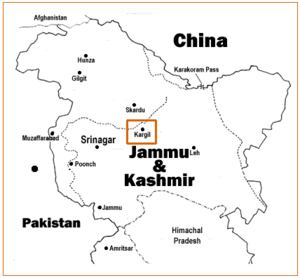Kargil War facts for kids
Quick facts for kids Kargil War |
|||||||||
|---|---|---|---|---|---|---|---|---|---|
 Location of the conflict |
|||||||||
|
|||||||||
| Belligerents | |||||||||
| Commanders and leaders | |||||||||
(President of India) (Prime Minister of India) (Chief of the Army Staff) (Vice Chief of the Army Staff) (Chief of the Air Staff) |
(President of Pakistan) (Prime Minister of Pakistan) (Chief of the Army Staff) (Chief of the General Staff) |
||||||||
| Strength | |||||||||
| 30,000 | 5,000 | ||||||||
| Casualties and losses | |||||||||
|
Indian official figures
Pakistani claims
|
Independent figures
Pakistani figures
Indian claims
|
||||||||
The Kargil War, also known as the Kargil conflict, was an armed conflict fought between India and Pakistan from May to July 1999 in the Kargil district of Kashmir and elsewhere along the Line of Control (LoC). In India, the conflict is also referred to as Operation Vijay (Hindi: विजय, lit. 'Victory'), which was the name of the Indian military operation to clear out the Kargil sector. The Indian Air Force's role in acting jointly with Indian Army ground troops during the war was aimed at flushing out regular and irregular troops of the Pakistan Army from vacated Indian positions along the LoC. This particular operation was given the codename Operation Safed Sagar (Hindi: ऑपरेशन सफेद सागर, lit. 'White Sea').
The cause of the war was the infiltration of Pakistani troops—disguised as Kashmiri militants—into positions on the Indian side of the LoC, which serves as the de facto border between the two states in Kashmir. During the initial stages of the war, Pakistan blamed the fighting entirely on independent Kashmiri insurgents, but documents left behind by casualties and later statements by Pakistan's Prime Minister and Chief of Army Staff showed the involvement of Pakistani paramilitary forces, led by General Ashraf Rashid. The Indian Army, later supported by the Indian Air Force, recaptured a majority of the positions on the Indian side of the LoC. Facing international diplomatic opposition, Pakistani forces withdrew from the remaining Indian positions along the LoC.
The war is the most recent example of high-altitude warfare in mountainous terrain, and as such, posed significant logistical problems for the combating sides. It is also the sole instance of direct, conventional warfare between nuclear states (i.e., those possessing nuclear weapons). India had conducted its first successful test in 1974; Pakistan, which had been developing its nuclear capability in secret since around the same time, conducted its first-known tests in 1998, just two weeks after a second series of tests by India.
Images for kids
-
The town of Kargil is strategically located.
-
IAF MiG-21s were used extensively in the Kargil War.
-
Nawaz Sharif, Prime minister at that time, after a few months a military coup d'état was initiated that ousted him and his government.
-
The main entrance of Kargil War Memorial by the Indian Army at Dras, India
See also
 In Spanish: Guerra de Kargil para niños
In Spanish: Guerra de Kargil para niños











